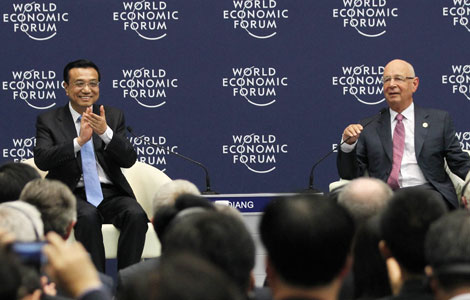

Experts: Services drive job creation, while structural problems remain
The job market remains healthy despite an economic slowdown in the first half of this year, according to official data.
Though economic growth slowed to 7.6 percent in the first half, the job market is showing increased resilience against the pressures of a fluctuating economy, which is giving the government encouragement to continue structural reforms.
Still, analysts say there are many challenges to job creation and retention that must be addressed.
|
Workers inquire about one of 2,900 posts employers are seeking to fill at a job fair in the city of Hefei, Anhui province, in September. Despite a slowing economy, China's job market will continue to grow in the next few years thanks to healthy growth in the service sector, analysts say. Liu Xijun / Xin Hua |
In the first seven months of 2013, 8.44 million new jobs were created, fulfilling 93.8 percent of the target for the whole year, according to the National Development and Reform Commission.
This is remarkable given the fact that China's economic growth slowed to 7.6 percent during the same period, a year-on-year decrease from the 7.8 percent growth in the first half of 2012.
The figures are more staggering when one takes into account the massive layoffs that occurred in coastal regions in 2009 after the outbreak of global financial crisis, which forced top leaders to prioritize achieving 8 percent growth.
A popular Party slogan was "baoba", which literally translates to "Defend Eight" or, in other words, maintain 8 percent growth.
Now China's leadership is less concerned with the 8 percent baseline.
Premier Li Keqiang took the drop in GDP in stride. Much of his confidence came from the heartening statistics about employment.
China's employment elasticity, or its capacity to create jobs for everypercentage point of GDP growth, has strengthened, said Zhu Baoliang, chief economist with the State Information Center, a think tank under the National Development and Reform Commission, the nation's top economic planning agency.
He estimated that now every percentage point of GDP growth could create 1.4 to 1.5 million jobs.
By comparison, the same growth back in 2008 could only generate 800,000 to 1 million jobs.
If this is accurate, an annual 6.5 percent GDP growth is sufficient to realize the official employment target-9 million new jobs.
Perhaps China's leaders already have this calculation in mind.
Speaking at the US-China Strategic and Economic Dialogue last month, Finance Minister Lou Jiwei said 6.5 percent growth should not be problematic for the Chinese economy.
The major factor driving employment elasticity, according to experts, is the robust development of China's service sector, which is much more efficient when it comes to creating jobs relative to other areas of the economy.
In the first half of this year, China's service industry grew 8.3 percent year-on-year, outpacing the 7.6 percent growth in manufacturing and construction sectors.
China's service industry has gradually expanded its share in the whole economy.
In 2008, when the financial crisis broke out, the service industry took up 40.1 percent of the economy. Its share has since risen to 45.3 percent in 2012.
Considering that the economy is now 73 percent larger than it was in 2008, the ability of the nation's service industry to create jobs has grown considerably.
At the same time, the number of new jobseekers has not grown much.
At the beginning of this year, the National Bureau of Statistics announced that the working-age population, defined as aged between 15 to 59 years, dropped 3.45 million, which is the first time that this population has shrunk.
Chen Yong, chief economist with Haitong Securities, estimated that the population of active laborers, internationally defined as being aged from 15 to 64, would shrink by more than 1 million annually starting in 2014. After 2020, the number would fall 4 million annually.
The expanding service sector and shrinking workforce seemed to present a rosy picture for China's employment prospects.
But not all economists are optimistic about employment elasticity.
Lu Ming, an economics professor with Shanghai Jiaotong University, said an important reason why the economic slowdown has not been accompanied by rising unemployment is that the country's service sector was largely unscathed.
"The GDP slowdown was mainly attributed to capital intensive industries. Steel, cement, and shipbuilding industries have all suffered severe overcapacity this year.
"But these industries do not generate too many jobs either," Lu said.
Lu said the nation's ability to create jobs is essentially determined by its economic structure. For the past two decades, China's economy has consistently relied on heavy investment and manufacturing.
This is why its employment elasticity has remained low for a long time, Lu said.
As long as the structure does not change significantly, it is too early to say employment elasticity has really increased, Lu said.
"The improvement recently might be a temporary phenomenon," Lu said.
Zeng Xiangquan, dean of School of Labor and Human Resources, Renmin University of China, painted a gloomier picture.
"The present situation just could not be compared with what was going on in 2008.
"In the final quarter of 2008, China faced an acute global financial crisis and our exports plummeted," Zeng said.
"Millions of factories closed and workers lost their jobs. Now the economic growth moderated but is still growing."
Though the current job market is not bad, severe structural problems remain, he said.
Manufacturers still find it increasingly difficult to find workers, while college graduates are failing to secure satisfactory jobs.
The mismatch between skills of job seekers and the demands of employers persists.
One possible scenario is that manufacturers could be reluctant to lay off workers even as profits shrink because they know it will be difficult to recruit more, he said.
Though service sector is able to employ a huge workforce, most jobs created by the sector tend to be unstable and vulnerable to economic pressures, he said."So if you just look at general data, it's fine. But when you look deeper, you find considerable problems," Zeng said.
zhengyangpeng@chinadaily.com.cn
(China Daily 09/11/2013 page27)
 Concept cars at Frankfurt 2013 motor show
Concept cars at Frankfurt 2013 motor show
 Premier Li meets entrepreneurs, answers questions
Premier Li meets entrepreneurs, answers questions
 Premier stresses education equality
Premier stresses education equality
 Angry Birds theme park opens in E China
Angry Birds theme park opens in E China
 Consumer electronics fair opens in Berlin
Consumer electronics fair opens in Berlin
 'Victoria's Secret' turns out to sell house
'Victoria's Secret' turns out to sell house
 Jaguar Land Rover XF Art Edition at Chengdu auto show
Jaguar Land Rover XF Art Edition at Chengdu auto show